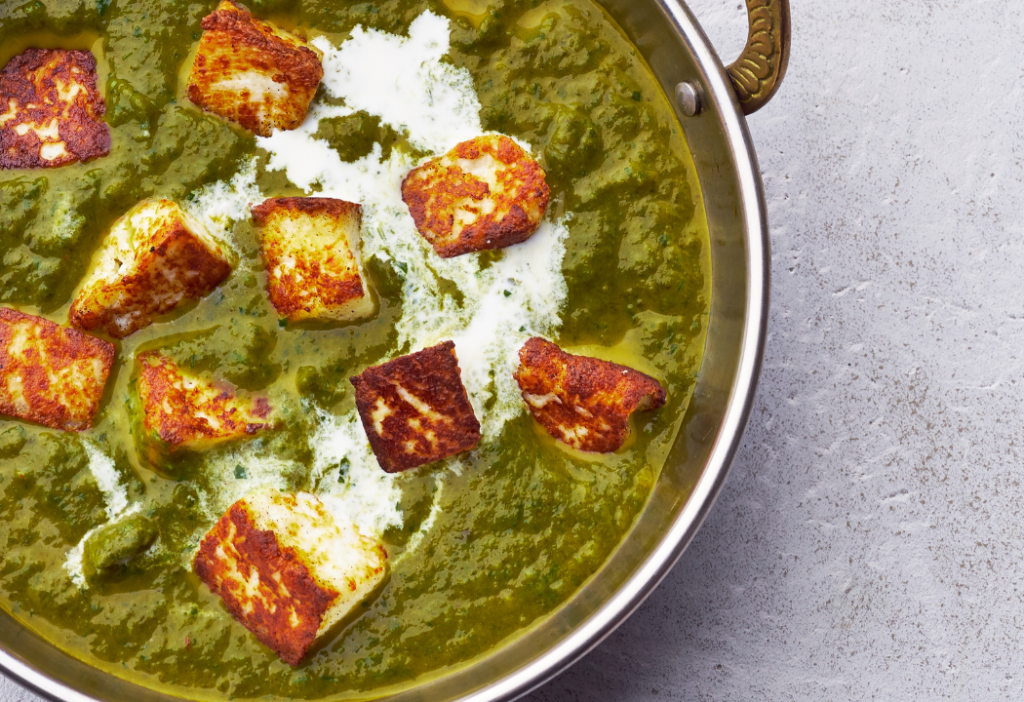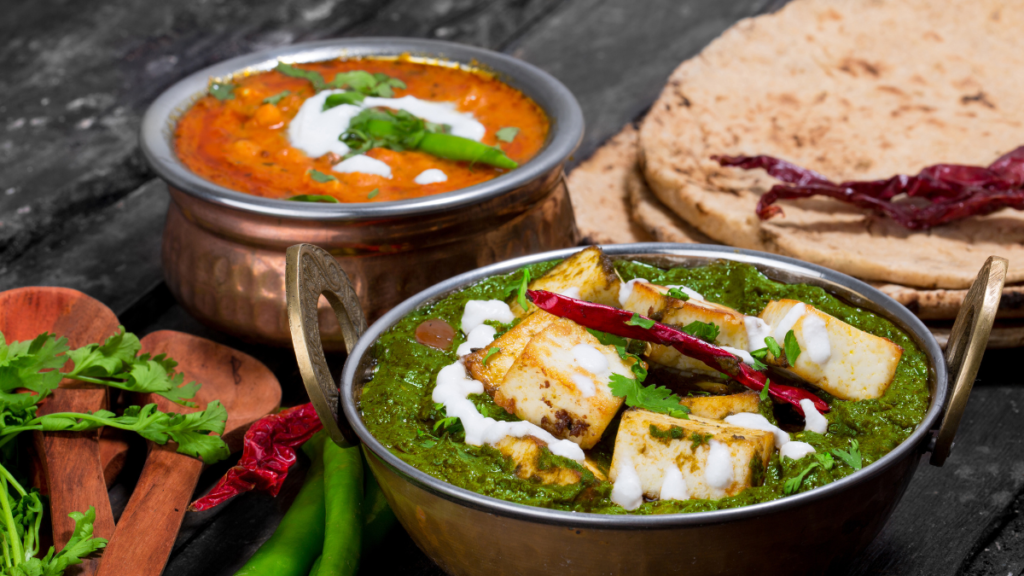No doubt , palak paneer is one of the most favourite dish in India. Indian paneer (Indian cheese) is cooked in a silky, decadent spinach sauce in this well-known vegetarian dish. Learn how to prepare the greatest palak paneer at home without overcrowding your plate with ingredients of spices or blanching the spinach.
This is more flavorful than anything you’ll find in a restaurant and is just amazing. Serve it with simple basmati rice, paratha, roti, butter nun, jeera rice, and ghee rice.
Regarding Palak Paneer
A traditional North Indian curry meal called “palak paneer” is cooked with fresh spinach, onions, spices, paneer, and herbs. The Hindi word for spinach is “palak,” and Indian cottage cheese is “paneer.” Palak paneer, then, refers to paneer that has been cooked in a flavorful, smooth, spicy gravy or sauce made from spinach. Restaurants enjoy greater popularity for the dish than do homes.
The traditional way to make palak paneer is to purée the spinach leaves after blanching them. Later, this spinach puree is simmered with herbs, tomatoes, and onions until it has the consistency of a thick curry.
Finally, that sauce is cooked with paneer. In most cases, additional cream is added to this for a restaurant-like touch.
Many people additionally include some milk for a distinctive flavour.
My method of preparing :
Even in the best restaurants when we were kids, we never liked palak paneer because of the way it taste and looked. I experimented with various methods of creating palak paneer before settling on this dish, which is always a major hit within the friend circle. This encourages me to write down this recipe for all.
The finest palak paneer you will ever make is this one. Simply avoiding blanching and undercooking your spinach will yield the greatest outcomes. Therefore, we sauté the spinach first before pureeing it to avoid blanching.
In many other recipes, such as dal palak, spinach paratha, palak rice, aloo palak, and many others, we clean, sauté the leaves till wilted, and prevent overcooking, otherwise, it will taste a little different .
Many individuals also inquire as to the similarity between palak paneer and saag paneer.
I respond to it here.
Saag paneer, on the other hand, is a dish that was created by chefs in Indian restaurants outside of India. Palak paneer is a genuine Indian dish that originated in India.
Palak means spinach, hence spinach is used to make palak paneer.
Saag, however, usually refers to a variety of greens, including fenugreek leaves, mustard greens, and radish greens.
In general, any or all of these are used to make saag. Therefore, you are more likely to consume any or all of these when you order saag paneer at a restaurant.
Saag paneer is prepared in a variety of ways, and each restaurant’s version will taste completely different. Unlike palak paneer, which is cooked with spinach, coriander, and methi (fenugreek) leaves, saag paneer is a completely distinct dish.

Making Palak Paneer in Hindi (Stepwise photos)
Preparation
- This recipe calls for 4/5 cups of palak leaves, loosely measured, or 2 cups, securely packed (100 to 120 grammes). Only use young, fresh spinach. Large stems or stalks should be avoided, especially those from mature spinach or palak because they bitterize the gravy. Whenever using young spinach, save the delicate stalks.
- In a big pot of water , thoroughly rinse the clean palak. Spray salt and vinegar to get rid of the pesticide residue. Rinse a few more times. Drain the water entirely. Follwing the instructions on the recipe card will alllow you to blanch the spinach if you are on low diet.
- Fill a pan with half a tablespoon of oil. then incorporate 1–2 chopped green chilies. This recipe doesn’t call for red chilli powder ( but if you can’t resist then add little chilli powder). So add enough green chilies to the dish to make it spicy. So adjust for as per need , otherwise it will be a chilli paneer.
- Include 8 to 10 cashew nuts and palak. Cook the palak on a medium heat until it totally wilts. This only takes two to three minutes. Avoid overcooking spinach; it just needs 2 to 3 minutes to cook.
- Verify that the leaves’ raw flavour has been eliminated. You can utilise all of the remaining spinach stock (moisture) for blending. You don’t have to evaporate it.
- Allow it to fully cool. These should be added to a blender jar. Fill the blender with 4/5 cups of clean water.
- Purée this stuff until it’s smooth. It must be both smooth and thick. Put that aside.
Method of preparing gravy
- Melt 1 or 2 tablespoon butter and 1 or 2 tablespoon oil in the same pan. 2 whole cardamoms, 1 inch of cinnamon, 2/3 cloves, and 1/8 teaspoon of cumin seeds should all be added. You can omit the whole spices if you don’t have any. However, since we won’t be using much garam masala powder, I utilise them.
- Include 4 cups of finely chopped or cooked onion paste. Onions should be fried till golden. Add 1 teaspoon of ginger garlic paste after that. Cook for one minute, or until the ginger and garlic start to smell.
- Next, add half a teaspoon of salt and finely chopped, deseeded half a cup of tomatoes or tomato puree. Well-sauté them.
- Add 2 to 4 teaspoons of garam masala when the tomatoes are completely mashed. Use a decent, flavorful garam masala, please. Sauté for 2 to 3 minutes, or until the masala is fragrant.
(Optional. You can also combine this with a cup of water if you don’t like lumpy curry. Read more in the recipe card notes. - Pour Add a cup or two of water and simmer the onions, covered, over medium heat until they are totally soft. Onion tomato masala must be thick but should have some water after cooking. Crush one-half teaspoon of kasuri methi in your palm. Put it in here.
A recipe for palak paneer
- Completely reduce the flame once the gravy has thickened. The pureed palak comes next. Mix it thoroughly, then cook it for approximately 2 minutes or until it starts to bubble. I advise against cooking for too long at this point since it taints the gravy. You can now stir in a few tablespoons of boiling water if you prefer your curry to be a little thinner. Add additional salt after tasting.
- Add paneer cubes.
- Stir thoroughly. Turn the stove off. Pour the cream now if using. If you used cashews to purée the spinach, you can omit the cream. Sincerly, cream is unnecessary for this recipe.
Serve the palak paneer with plain paratha, roti, butter noodles, or Jira rice.
Pro Advice
- Blanched vs. unblanched spinach: If you have been following a low-oxalate diet and do not often eat spinach without blanching it in other dishes like dal palak or any spinach curry, I would advise blanching.
Prior to preparing a puree, spinach is always blanched for palak paneer. However, if you want to create the greatest palak paneer, try it without blanching first.
You’ll doubtless be surprised by how tasty this dish is and how different it is from the one cooked with blanched spinach.
- Preserving the palak’s natural colour: To achieve the nicest colour, use as little garam masala as possible in this recipe and avoid overcooking the spinach, which will darken the dish.
- Smooth, creamy texture: To give the palak paneer gravy a little creamy texture, I added a few cashews. However, you may simply omit them and use 3 to 4 tbsp of cream instead. Blanched almonds are an additional option.
If using frozen store-bought paneer, soak it for 15 to 20 minutes in gently lukewarm water.
Drain, then apply. It remains supple thanks to this.
More palak recipes that I’ve published on the blog can be found here.
FAQS
What distinguishes saag paneer from palak paneer?
Different types of greens, including mustard greens, spinach, fenugreek, amaranth, and a few others, are referred to as saag. Any of these greens can be used to make saag paneer, but palak paneer is only made using palak (spinach).
What gives my palak paneer its bitter flavour?
Old, mature, huge, dark green spinach contains high quantities of oxalic acid, which gives it a bitter flavour. Using fresh spinach, which is more soft and flavorful, can avoid your palak paneer from being bitter. Furthermore, spinach becomes more bitter when overcooked. Cooking only takes a few minutes.
Can palak paneer be frozen?
Palak paneer can indeed be frozen for a month. Turn off the heat and let the onion, tomato, and masala mixture cool entirely. Keep it in an airtight container, then reheat and serve it as needed.
Palak: How to Choose
Whenever possible, use delicate palak that is light to medium green in hue. Usually, dark leaves are not as tasty.
Palak stems and stalks should not be used because they bitterize palak paneer. Additionally, a metallic flavour results.
